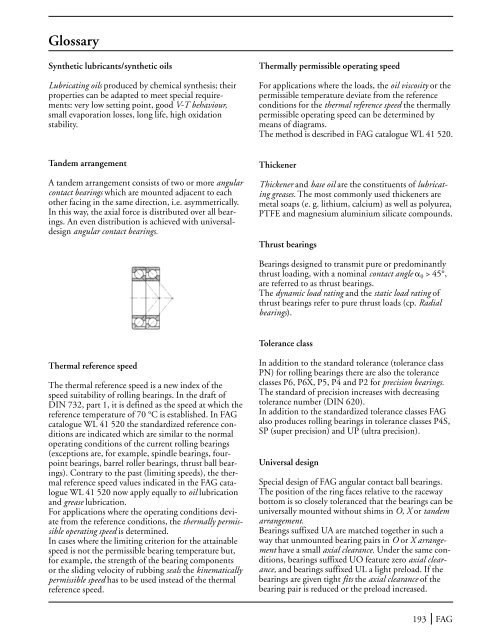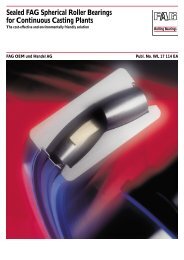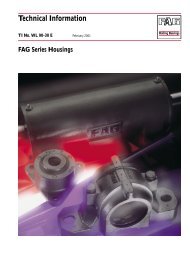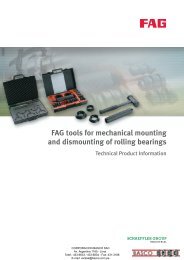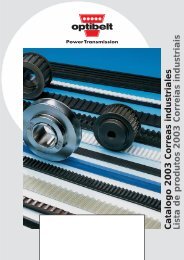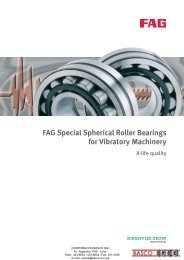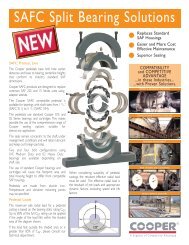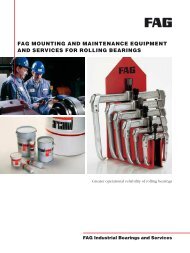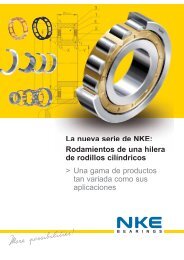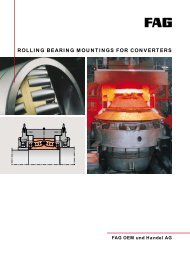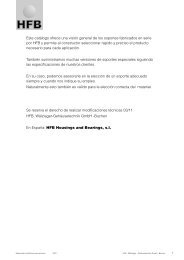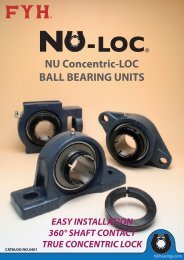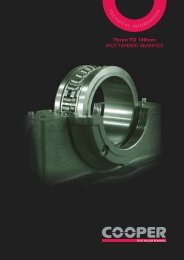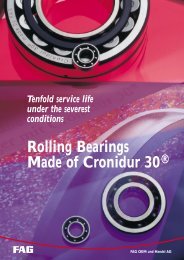Create successful ePaper yourself
Turn your PDF publications into a flip-book with our unique Google optimized e-Paper software.
GlossarySynthetic lubricants/synthetic oilsLubricating oils produced by chemical synthesis; theirproperties can be adapted to meet special requirements:very low setting point, good V-T behaviour,small evaporation losses, long life, high oxidationstability.<strong>The</strong>rmally permissible operating speedFor applications where the loads, the oil viscosity or thepermissible temperature deviate from the referenceconditions for the thermal reference speed the thermallypermissible operating speed can be determined bymeans <strong>of</strong> diagrams.<strong>The</strong> method is described in FAG catalogue WL 41 520.Tandem arrangementA tandem arrangement consists <strong>of</strong> two or more angularcontact bearings which are mounted adjacent to eachother facing in the same direction, i.e. asymmetrically.In this way, the axial force is distributed over all bearings.An even distribution is achieved with universaldesignangular contact bearings.ThickenerThickener and base oil are the constituents <strong>of</strong> lubricatinggreases. <strong>The</strong> most commonly used thickeners aremetal soaps (e. g. lithium, calcium) as well as polyurea,PTFE and magnesium aluminium silicate compounds.Thrust bearings<strong>Bearing</strong>s designed to transmit pure or predominantlythrust loading, with a nominal contact angle 0 > 45°,are referred to as thrust bearings.<strong>The</strong> dynamic load rating and the static load rating <strong>of</strong>thrust bearings refer to pure thrust loads (cp. Radialbearings).Tolerance class<strong>The</strong>rmal reference speed<strong>The</strong> thermal reference speed is a new index <strong>of</strong> thespeed suitability <strong>of</strong> rolling bearings. In the draft <strong>of</strong>DIN 732, part 1, it is defined as the speed at which thereference temperature <strong>of</strong> 70 °C is established. In FAGcatalogue WL 41 520 the standardized reference conditionsare indicated which are similar to the normaloperating conditions <strong>of</strong> the current rolling bearings(exceptions are, for example, spindle bearings, fourpointbearings, barrel roller bearings, thrust ball bearings).Contrary to the past (limiting speeds), the thermalreference speed values indicated in the FAG catalogueWL 41 520 now apply equally to oil lubricationand grease lubrication.For applications where the operating conditions deviatefrom the reference conditions, the thermally permissibleoperating speed is determined.In cases where the limiting criterion for the attainablespeed is not the permissible bearing temperature but,for example, the strength <strong>of</strong> the bearing componentsor the sliding velocity <strong>of</strong> rubbing seals the kinematicallypermissible speed has to be used instead <strong>of</strong> the thermalreference speed.In addition to the standard tolerance (tolerance classPN) for rolling bearings there are also the toleranceclasses P6, P6X, P5, P4 and P2 for precision bearings.<strong>The</strong> standard <strong>of</strong> precision increases with decreasingtolerance number (DIN 620).In addition to the standardized tolerance classes FAGalso produces rolling bearings in tolerance classes P4S,SP (super precision) and UP (ultra precision).Universal designSpecial design <strong>of</strong> FAG angular contact ball bearings.<strong>The</strong> position <strong>of</strong> the ring faces relative to the racewaybottom is so closely toleranced that the bearings can beuniversally mounted without shims in O, X or tandemarrangement.<strong>Bearing</strong>s suffixed UA are matched together in such away that unmounted bearing pairs in O or X arrangementhave a small axial clearance. Under the same conditions,bearings suffixed UO feature zero axial clearance,and bearings suffixed UL a light preload. If thebearings are given tight fits the axial clearance <strong>of</strong> thebearing pair is reduced or the preload increased.193 FAG


